Analysis of Walking-Edge Effect in Train Station Evacuation Scenarios: A Sustainable Transportation Perspective
Abstract
1. Introduction
2. Materials and Methods
2.1. Evacuation Model
2.2. Validation
2.3. Physical Model
2.4. Simulation Scenarios
- SS 2-1: The two exits (1.5 m) are located at the midpoint of line and line (i.e., position , ) respectively;
- SS 2-2: Retain the position of original exit (1 m) and add two exits (1 m) at position , ;
- SS 2-3: Retain the position of original exit (1 m) and change two exits’ (1 m) location to the edge position , .
- SS 3-1: Combine two service counters into one (6 m × 2 m) and set it at the midpoint of line (i.e., position );
- SS 3-2: Retain the two service counters (3 m × 2 m) and symmetrically set them at position , ;
- SS 3-3: Funnel-shaped side exits of corridors between a number of seats and walls were designed (Figure 5).
2.5. Evacuation Parameter Setting
- Based on the study of Lei et al. [55], the initial response time was uniformly distributed in the interval [0 s, 30 s].
- Combining the research [56] and observation results, the initial speed was uniformly distributed in the interval [0.3 m/s, 0.7 m/s], and the desired speed is approximately Gaussian-distributed with a mean value of 0.8 m/s and a standard deviation of 0.1 m/s.
- According to Xie et al. [57], the radius of passengers was set to [0.125 m, 0.25 m].
3. Simulation Results
3.1. Evacuation Efficiency
3.2. Pedestrian Flow
3.3. Density Map
4. Discussion
4.1. Effect of the Exit Layouts
4.2. Effect of the Obstacles Layouts
5. Conclusions
Author Contributions
Funding
Conflicts of Interest
References
- Alawad, H.; Kaewunruen, S. Wireless sensor networks: Toward smarter railway stations. Infrastructures 2018, 3, 24. [Google Scholar] [CrossRef]
- Xu, H.; Zhang, Y.; Li, H.; Skitmore, M.; Yang, J.; Yu, F. Safety risks in rail stations: An interactive approach. J. Rail Transp. Plan. Manag. 2019, 11, 100148. [Google Scholar] [CrossRef]
- Chinese make over 400 million trips by rail during Spring Festival. Available online: http://en.people.cn/n3/2019/0306/c90000-9553069.html (accessed on 6 March 2019).
- Fridolf, K.; Nilsson, D.; Frantzich, H. Fire evacuation in underground transportation systems: A review of accidents and empirical research. Fire Technol. 2013, 49, 451–475. [Google Scholar] [CrossRef]
- Mumbai stampede kills 23, injures 39 at train station. Available online: https://edition.cnn.com/2017/09/29/asia/india-mumbai-stampede/index.html (accessed on 29 September 2017).
- Pretoria train stampede injures 17. Available online: https://www.news24.com/SouthAfrica/News/Pretoria-train-stampede-injures-17-20120510 (accessed on 10 May 2012).
- Pel, A.J.; Bel, N.H.; Pieters, M. Including passengers’ response to crowding in the Dutch national train passenger assignment model. Transp. Res. Part A 2014, 66, 111–126. [Google Scholar] [CrossRef]
- Kim, K.M.; Hong, S.-P.; Ko, S.-J.; Kim, D. Does crowding affect the path choice of metro passengers? Transp. Res. Part A Policy Pract. 2015, 77, 292–304. [Google Scholar] [CrossRef]
- Shiwakoti, N.; Sarvi, M. Enhancing the panic escape of crowd through architectural design. Tramsport. Res. Part C Emerg. Technol. 2013, 37, 260–267. [Google Scholar] [CrossRef]
- Fridolf, K.; Nilsson, D.; Frantzich, H. The flow rate of people during train evacuation in rail tunnels: Effects of different train exit configurations. Saf. Sci. 2014, 62, 515–529. [Google Scholar] [CrossRef]
- Shiwakoti, N.; Tay, R.; Stasinopoulos, P.; Woolley, P.J. Likely behaviours of passengers under emergency evacuation in train station. Saf. Sci. 2017, 91, 40–48. [Google Scholar] [CrossRef]
- Shi, X.; Ye, Z.; Shiwakoti, N.; Li, H. Passengers’ perceptions of security check in metro stations. Sustainability 2019, 11, 2930. [Google Scholar] [CrossRef]
- Shiwakoti, N.; Tay, R.; Stasinopoulos, P.; Woolley, P.J. Passengers’ awareness and perceptions of way finding tools in a train station. Saf. Sci. 2016, 87, 179–185. [Google Scholar] [CrossRef]
- Shiwakoti, N.; Tay, R.; Stasinopoulos, P.; Woolley, P. Passengers’ perceived ability to get out safely from an underground train station in an emergency situation. Cogn. Technol. Work 2018, 20, 367–375. [Google Scholar] [CrossRef]
- Seriani, S.; Fujiyama, T. Modelling the distribution of passengers waiting to board the train at metro stations. J. Rail Transp. Plan. Manag. 2019, 11, 100141. [Google Scholar] [CrossRef]
- Haghani, M.; Sarvi, M. Crowd behaviour and motion: Empirical methods. Transp. Res. Part B Methodol. 2018, 107, 253–294. [Google Scholar] [CrossRef]
- Shi, X.; Ye, Z.; Shiwakoti, N.; Li, Z. A review of experimental studies on complex pedestrian movement behaviors. In Proceedings of the CICTP 2015, Beijing, China, 24–27 July 2015; pp. 1081–1096. [Google Scholar]
- Zeng, W.; Chen, P.; Nakamura, H.; Iryo-Asano, M. Application of social force model to pedestrian behavior analysis at signalized crosswalk. Transp. Res. Part C Emerg. Technol. 2014, 40, 143–159. [Google Scholar] [CrossRef]
- Li, Y.; Chen, M.; Dou, Z.; Zheng, X.; Cheng, Y.; Mebarki, A. A review of cellular automata models for crowd evacuation. Phys. A Stat. Mech. Appl. 2019, 3, 1–24. [Google Scholar] [CrossRef]
- Vermuyten, H.; Beliën, J.; De Boeck, L.; Reniers, G.; Wauters, T. A review of optimisation models for pedestrian evacuation and design problems. Saf. Sci. 2016, 87, 167–178. [Google Scholar] [CrossRef]
- Guelpa, E.; Toro, C.; Sciacovelli, A.; Melli, R.; Sciubba, E.; Verda, V. Optimal operation of large district heating networks through fast fluid-dynamic simulation. Energy 2016, 102, 586–595. [Google Scholar] [CrossRef]
- Guo, X.; Chen, J.; You, S.; Wei, J. Modeling of pedestrian evacuation under fire emergency based on an extended heterogeneous lattice gas model. Phys. A Stat. Mech. Appl. 2013, 392, 1994–2006. [Google Scholar] [CrossRef]
- Duives, D.C.; Daamen, W.; Hoogendoorn, S.P. State-of-the-art crowd motion simulation models. Transp. Res. Part C Emerg. Technol. 2013, 37, 193–209. [Google Scholar] [CrossRef]
- Tang, T.-Q.; Shao, Y.-X.; Chen, L. Modeling pedestrian movement at the hall of high-speed railway station during the check-in process. Phys. A Stat. Mech. Appl. 2017, 467, 157–166. [Google Scholar] [CrossRef]
- Wang, L.; Zhang, Q.; Cai, Y.; Zhang, J.; Ma, Q. Simulation study of pedestrian flow in a station hall during the Spring Festival travel rush. Phys. A Stat. Mech. Appl. 2013, 392, 2470–2478. [Google Scholar] [CrossRef]
- Xuetong, H.; Shunbing, Z.; Xun, L.; Weiqiang, Z. Research on Personnel Evacuation of Departure Platform of Nanjing South Railway Station Based on Anylogic. In Proceedings of the 2018 IEEE International Conference of Safety Produce Informatization (IICSPI), Chongqing, China, 10–12 December 2018; IEEE: New York, NY, USA, 2018; pp. 62–66. [Google Scholar]
- Lei, W.; Tai, C. Effect of different staircase and exit layouts on occupant evacuation. Saf. Sci. 2019, 118, 258–263. [Google Scholar] [CrossRef]
- Chooramun, N.; Lawrence, P.; Galea, E. Evacuation simulation using Hybrid Space Discretisation and application to large underground rail tunnel station. Phys. Sci. Rev. 2017, 2, 191–204. [Google Scholar]
- Farina, F.; Fontanelli, D.; Garulli, A.; Giannitrapani, A.; Prattichizzo, D. Walking ahead: The headed social force model. PLoS ONE 2017, 12, e0169734. [Google Scholar] [CrossRef]
- Langston, P.A.; Masling, R.; Asmar, B.N. Crowd dynamics discrete element multi-circle model. Saf. Sci. 2006, 44, 395–417. [Google Scholar] [CrossRef]
- Qu, Y.; Gao, Z.; Xiao, Y.; Li, X. Modeling the pedestrian’s movement and simulating evacuation dynamics on stairs. Saf. Sci. 2014, 70, 189–201. [Google Scholar] [CrossRef]
- Yuen, J.; Lee, E. The effect of overtaking behavior on unidirectional pedestrian flow. Saf. Sci. 2012, 50, 1704–1714. [Google Scholar] [CrossRef]
- Hou, L.; Liu, J.-G.; Pan, X.; Wang, B.-H. A social force evacuation model with the leadership effect. Phys. A Stat. Mech. Appl. 2014, 400, 93–99. [Google Scholar] [CrossRef]
- Ma, Y.; Lee, E.W.M.; Shi, M. Dual effects of guide-based guidance on pedestrian evacuation. Phys. Lett. A 2017, 381, 1837–1844. [Google Scholar] [CrossRef]
- Liu, J.; Chen, X. Simulation of passenger motion in metro stations during rush hours based on video analysis. Autom. Constr. 2019, 107, 102938. [Google Scholar] [CrossRef]
- Moussaïd, M.; Helbing, D.; Theraulaz, G. How simple rules determine pedestrian behavior and crowd disasters. Proc. Natl. Acad. Sci. USA 2011, 108, 6884–6888. [Google Scholar] [CrossRef] [PubMed]
- Dossetti, V.; Bouzat, S.; Kuperman, M.N. Behavioral effects in room evacuation models. Phys. A Stat. Mech. Appl. 2017, 479, 193–202. [Google Scholar] [CrossRef]
- Hong, L.; Gao, J.; Zhu, W. Self-evacuation modelling and simulation of passengers in metro stations. Saf. Sci. 2018, 110, 127–133. [Google Scholar] [CrossRef]
- Rigos, A.; Mohlin, E.; Ronchi, E. The cry wolf effect in evacuation: A game-theoretic approach. Phys. A Stat. Mech. Appl. 2019, 526, 120890. [Google Scholar] [CrossRef]
- Liu, S.; Liu, J.; Wei, W. Simulation of crowd evacuation behaviour in outdoor public places: A model based on Shanghai stampede. Int. J. Simul. Model. 2019, 18, 86–99. [Google Scholar] [CrossRef]
- de Almeida, M.M.; von Schreeb, J. Human stampedes: An updated review of current literature. Prehosp. Disaster Med. 2019, 34, 82–88. [Google Scholar] [CrossRef]
- Wagner, N.; Agrawal, V. An agent-based simulation system for concert venue crowd evacuation modeling in the presence of a fire disaster. Expert Syst. Appl. 2014, 41, 2807–2815. [Google Scholar] [CrossRef]
- Khan, S.D. Congestion detection in pedestrian crowds using oscillation in motion trajectories. Eng. Appl. Artif. Intell. 2019, 85, 429–443. [Google Scholar] [CrossRef]
- Xie, K.; Liu, Z.; Fu, L.; Liang, B. Internet of things-based intelligent evacuation protocol in libraries. Libr. Hi Tech. 2019. [Google Scholar] [CrossRef]
- Peng, Y.; Li, S.-W.; Hu, Z.-Z. A self-learning dynamic path planning method for evacuation in large public buildings based on neural networks. Neurocomputing 2019, 365, 71–85. [Google Scholar] [CrossRef]
- Helbing, D.; Farkas, I.; Vicsek, T. Simulating dynamical features of escape panic. Nature 2000, 407, 487. [Google Scholar] [CrossRef] [PubMed]
- Wan, J.; Sui, J.; Yu, H. Research on evacuation in the subway station in China based on the Combined Social Force Model. Phys. A Stat. Mech. Appl. 2014, 394, 33–46. [Google Scholar] [CrossRef]
- Wuchang railway station. Available online: https://en.wikipedia.org/wiki/Wuchang_railway_station (accessed on 12 May 2019).
- Google Earth. Available online: http://www.earth.google.com. (accessed on 31 October 2019).
- Li, Y.; Cai, W.; Kana, A.A. Design of level of service on facilities for crowd evacuation using genetic algorithm optimization. Saf. Sci. 2019, 120, 237–247. [Google Scholar] [CrossRef]
- Chen, S.; Fu, L.; Fang, J.; Yang, P. The effect of obstacle layouts on pedestrian flow in corridors: An experimental study. Phys. A Stat. Mech. Appl. 2019, 534, 122333. [Google Scholar] [CrossRef]
- Shiwakoti, N.; Shi, X.; Ye, Z. A review on the performance of an obstacle near an exit on pedestrian crowd evacuation. Saf. Sci. 2019, 113, 54–67. [Google Scholar] [CrossRef]
- Frank, G.A.; Dorso, C.O. Room evacuation in the presence of an obstacle. Phys. A Stat. Mech. Appl. 2011, 390, 2135–2145. [Google Scholar] [CrossRef]
- Helbing, D.; Buzna, L.; Johansson, A.; Werner, T. Self-organized pedestrian crowd dynamics: Experiments, simulations, and design solutions. Transp. Sci. 2005, 39, 1–24. [Google Scholar] [CrossRef]
- Lei, W.; Li, A.; Gao, R.; Zhou, N.; Mei, S.; Tian, Z. Experimental study and numerical simulation of evacuation from a dormitory. Phys. A Stat. Mech. Appl. 2012, 391, 5189–5196. [Google Scholar] [CrossRef]
- Lei, W.; Li, A.; Gao, R.; Wang, X. Influences of exit and stair conditions on human evacuation in a dormitory. Phys. A Stat. Mech. Appl. 2012, 391, 6279–6286. [Google Scholar] [CrossRef]
- Xie, K.; Song, Y.; Liu, J.; Liang, B.; Liu, X. Stampede prevention design of primary school buildings in china: A sustainable built environment perspective. Int. J. Environ. Res. Public Health 2018, 15, 1517. [Google Scholar] [CrossRef]
- Kolli, S. Multi-Agent management of crowds to avoid stampedes in long queues. Master‘s Thesis, International Institute of Information Technology, Hyderabad, India, July 2014. [Google Scholar]
- Han, Y.; Liu, H.; Moore, P. Extended route choice model based on available evacuation route set and its application in crowd evacuation simulation. Simul. Model. Pract. Theory 2017, 75, 1–16. [Google Scholar] [CrossRef]
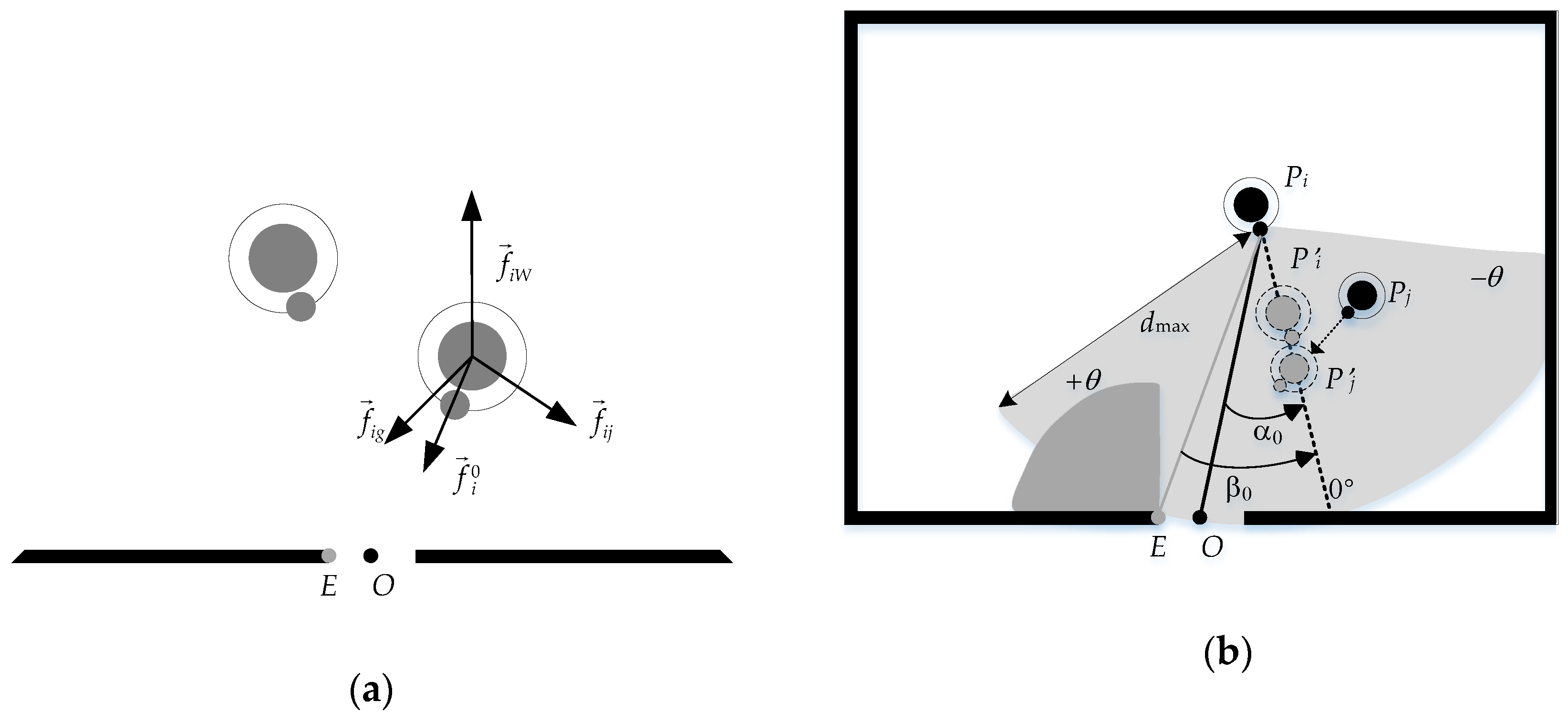
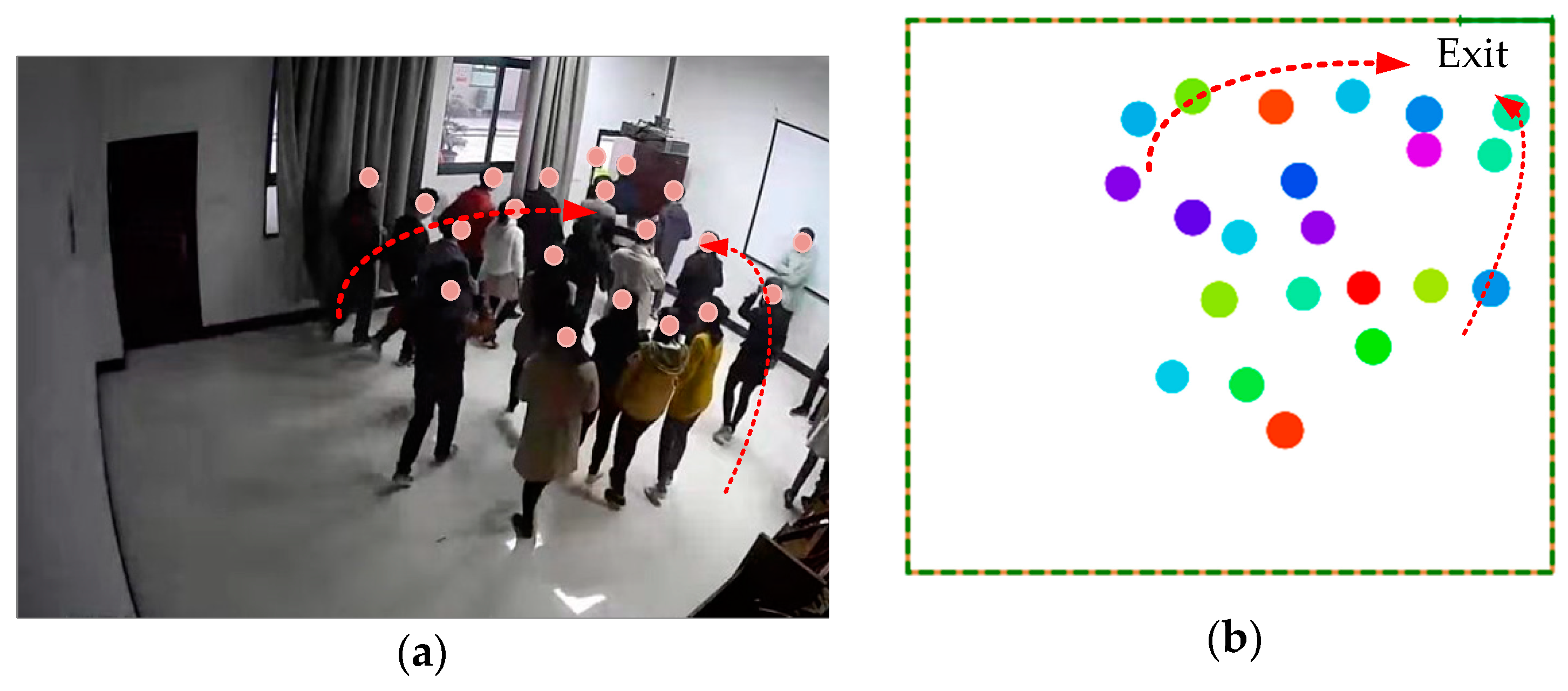
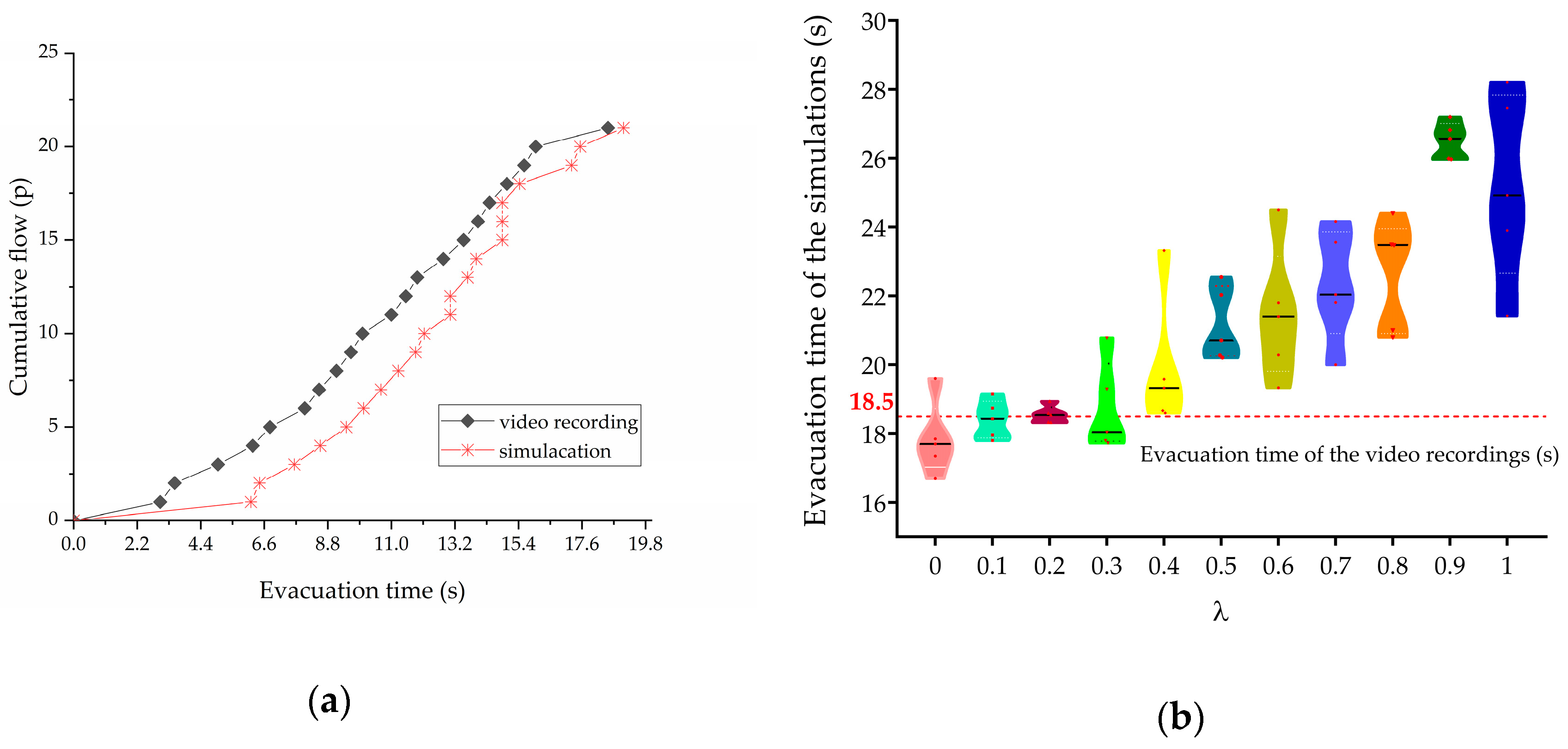


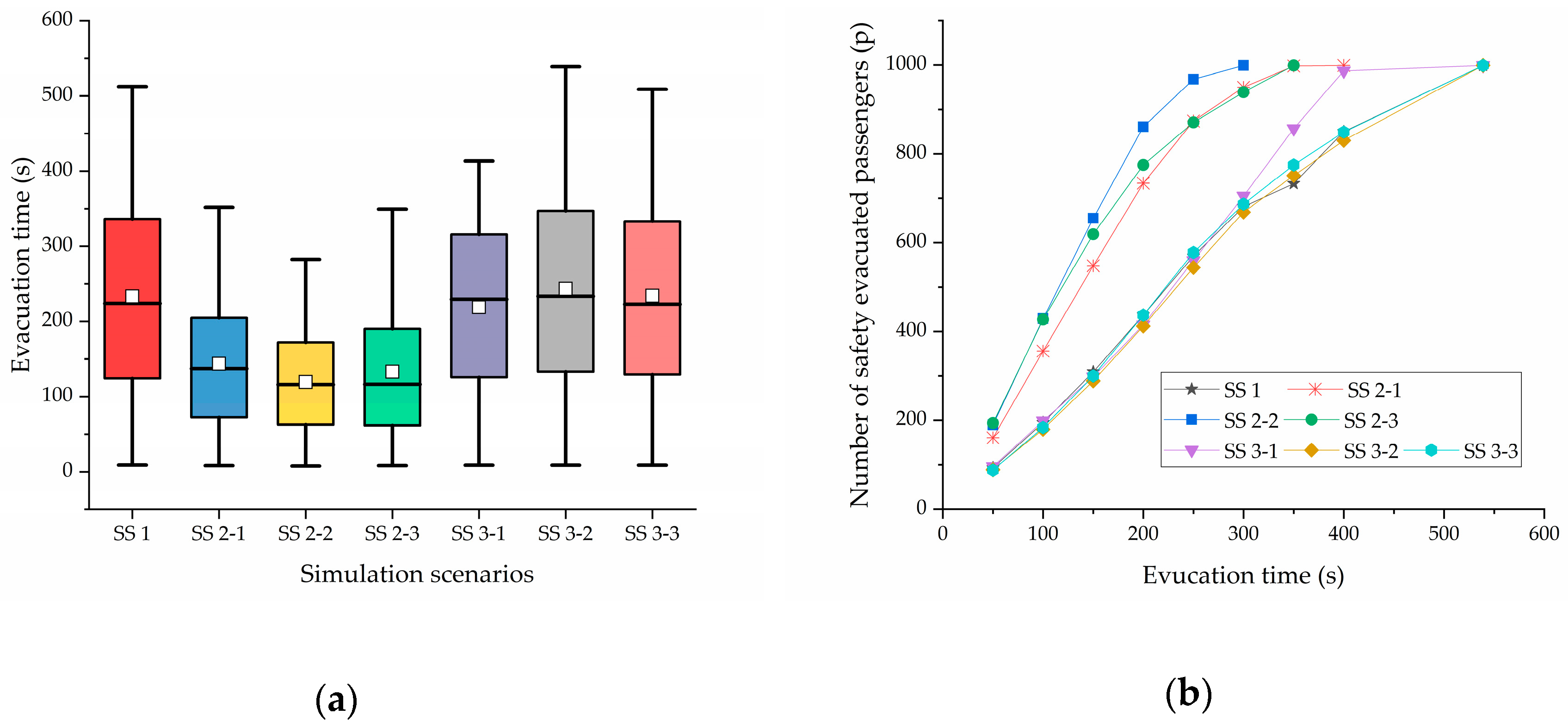

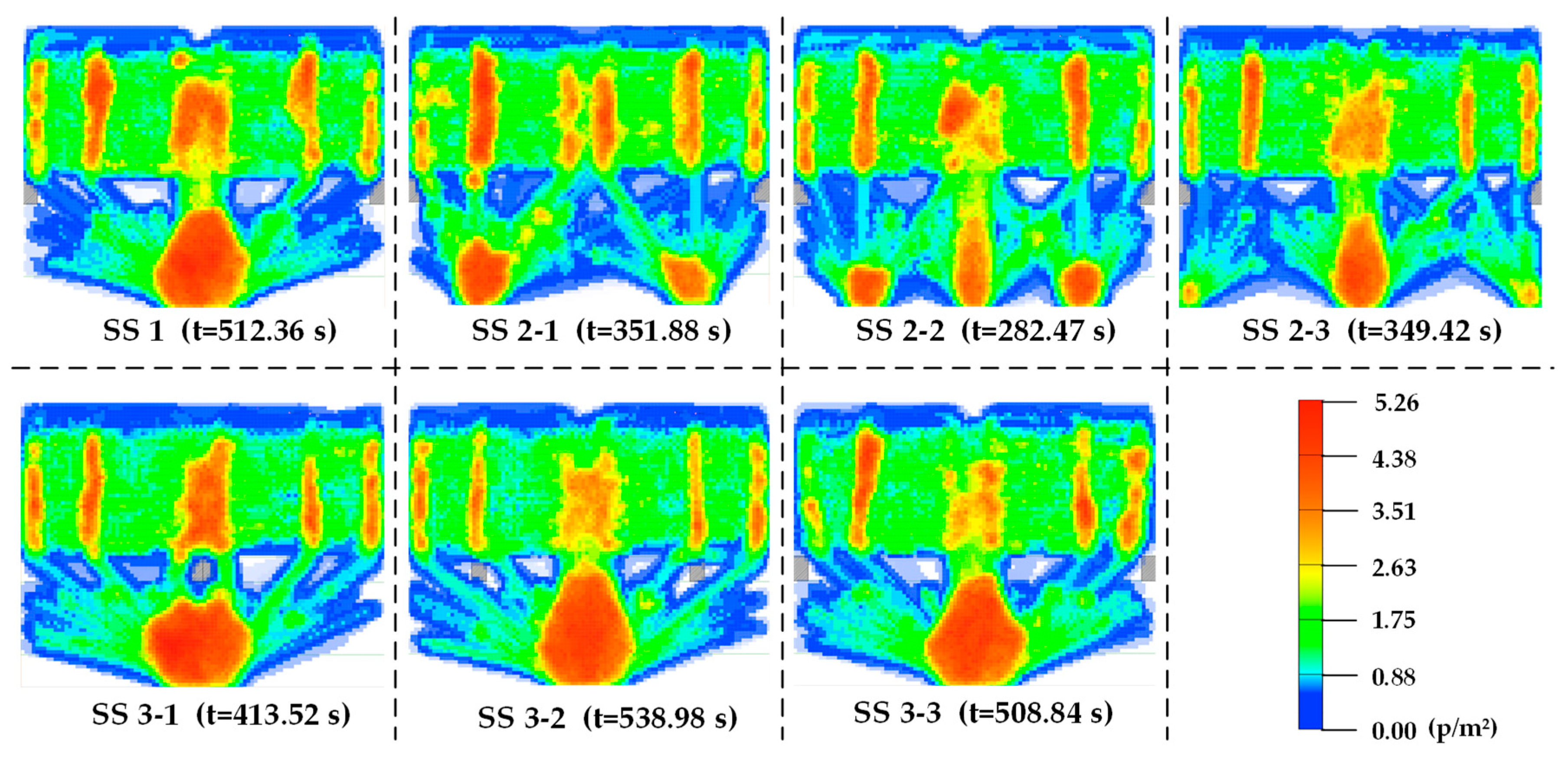
| Time Interval (s) | Number of Safely Evacuated People (p) | Evacuation Efficiency (p/s) | ||||||||||||
|---|---|---|---|---|---|---|---|---|---|---|---|---|---|---|
| SS 1 | SS 2-1 | SS 2-2 | SS 2-3 | SS 3-1 | SS 3-2 | SS 3-3 | SS 1 | SS 2-1 | SS 2-2 | SS 2-3 | SS 3-1 | SS 3-2 | SS 3-3 | |
| 0–50 | 93 | 161 | 190 | 194 | 96 | 89 | 88 | 1.86 | 3.22 | 3.80 | 3.88 | 1.92 | 1.78 | 1.76 |
| 50–100 | 102 | 195 | 239 | 233 | 103 | 91 | 96 | 2.04 | 3.90 | 4.78 | 4.66 | 2.06 | 1.82 | 1.92 |
| 100–150 | 114 | 192 | 226 | 192 | 99 | 109 | 116 | 2.28 | 3.84 | 4.52 | 3.84 | 1.98 | 2.18 | 2.32 |
| 150–200 | 128 | 186 | 206 | 156 | 117 | 123 | 137 | 2.56 | 3.72 | 4.12 | 3.12 | 2.34 | 2.46 | 2.74 |
| 200–250 | 133 | 140 | 107 | 96 | 145 | 132 | 141 | 2.66 | 2.80 | 2.14 | 1.92 | 2.90 | 2.64 | 2.82 |
| 250–300 | 111 | 76 | 31 | 68 | 145 | 125 | 109 | 2.22 | 1.52 | 0.62 | 1.36 | 2.90 | 2.50 | 2.18 |
| 300–350 | 52 | 48 | − | 60 | 152 | 82 | 88 | 1.04 | 0.96 | − | 1.20 | 3.04 | 1.64 | 1.76 |
| 350–400 | 117 | 1 | − | − | 130 | 79 | 74 | 2.34 | 0.02 | − | − | 2.60 | 1.58 | 1.48 |
| 400–539 | 149 | − | − | − | 12 | 169 | 150 | 1.07 | − | − | − | 0.09 | 1.22 | 1.08 |
| Simulation Scenarios | Exit | Flow Rate of Passengers (p/s) | ||||
|---|---|---|---|---|---|---|
| Mean | Maximum | Minimum | Median | Standard Deviation | ||
| SS 1 | 1620 | 2560 | 36 | 1856 | 815 | |
| SS 2-1 | 1995 | 3539 | 83 | 2040 | 1122 | |
| 1565 | 3471 | 83 | 1505 | 944 | ||
| SS 2-2 | 1862 | 3492 | 12 | 1836 | 1115 | |
| 1767 | 3780 | 12 | 1728 | 1053 | ||
| 1833 | 3924 | 168 | 1896 | 1016 | ||
| SS 2-3 | 2084 | 5076 | 72 | 1800 | 1451 | |
| 1701 | 2688 | 120 | 1824 | 850 | ||
| 1591 | 2556 | 96 | 1764 | 816 | ||
| SS 3-1 | 1572 | 2840 | 40 | 1576 | 907 | |
| SS 3-2 | 1732 | 2640 | 52 | 1916 | 810 | |
| SS 3-3 | 1626 | 2704 | 36 | 1788 | 858 | |
© 2019 by the authors. Licensee MDPI, Basel, Switzerland. This article is an open access article distributed under the terms and conditions of the Creative Commons Attribution (CC BY) license (http://creativecommons.org/licenses/by/4.0/).
Share and Cite
Xie, K.; Liang, B.; Song, Y.; Dong, X. Analysis of Walking-Edge Effect in Train Station Evacuation Scenarios: A Sustainable Transportation Perspective. Sustainability 2019, 11, 7188. https://doi.org/10.3390/su11247188
Xie K, Liang B, Song Y, Dong X. Analysis of Walking-Edge Effect in Train Station Evacuation Scenarios: A Sustainable Transportation Perspective. Sustainability. 2019; 11(24):7188. https://doi.org/10.3390/su11247188
Chicago/Turabian StyleXie, Kefan, Benbu Liang, Yu Song, and Xueqin Dong. 2019. "Analysis of Walking-Edge Effect in Train Station Evacuation Scenarios: A Sustainable Transportation Perspective" Sustainability 11, no. 24: 7188. https://doi.org/10.3390/su11247188
APA StyleXie, K., Liang, B., Song, Y., & Dong, X. (2019). Analysis of Walking-Edge Effect in Train Station Evacuation Scenarios: A Sustainable Transportation Perspective. Sustainability, 11(24), 7188. https://doi.org/10.3390/su11247188






